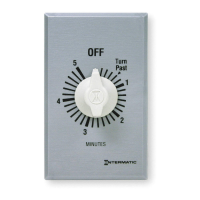
Do you have a question about the Intermatic FF5M and is the answer not in the manual?
| Brand | Intermatic |
|---|---|
| Model | FF5M |
| Category | Timer |
| Language | English |
Timer should not be used in precision timing applications where inaccurate timing could have dangerous consequences.
Ensure electrical power is turned off at the breaker or fuse panel before installation.
Remove the wall plate and disconnect the existing switch from the junction box.
Strip the end of wires to 1/2 inch long as per the strip gauge on the back of the timer.
Insert stripped wire ends under terminal screws and screw down tightly.
Insert the wired timer into the junction box and fasten using provided screws.
Slip the metal time dial plate over the threaded extension, aligning the 'OFF' mark.
Fasten the metal dial plate securely to the timer using the provided stamped nut.
Place the standard toggle or decorator plate on the timer, do not over tighten.
Slip the plastic time dial plate over the threaded extension and secure with the nut.
Push the knob onto the timer shaft, centering the pointer on 'OFF' on the dial plate.
Turn the electrical power back on at the breaker or fuse panel.
Turn the timer clockwise to the desired time for automatic shut-off.
Turn counterclockwise to stop operation; switch remains 'ON' until manually returned to 'OFF'.
Used for breaking the hot side of 120-volt loads like coffee pots, lights, and fans.
For 3-way switching or reverse action applications, controlling loads from multiple locations.
For switching both sides of 208, 240, or 277-volt loads like large motors and lighting.
Details maximum time cycles, voltage, and amperage ratings for different timer configurations.
Lists current models for SPST, SPDT, and DPST types, with and without hold features.
Instructions on changing prefixes for decorator style plates and adding suffixes for color options.
Details the one-year limited warranty, exclusions, and service procedures.
